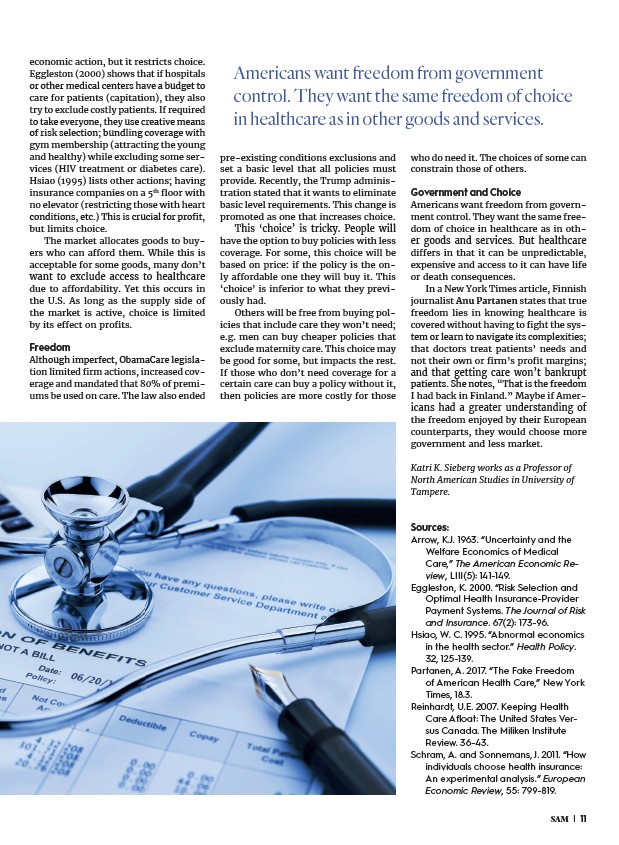
economic action, but it restricts choice.
Eggleston (2000) shows that if hospitals
or other medical centers have a budget to
care for patients (capitation), they also
try to exclude costly patients. If required
to take everyone, they use creative means
of risk selection; bundling coverage with
gym membership (attracting the young
and healthy) while excluding some services
(HIV treatment or diabetes care).
Hsiao (1995) lists other actions; having
insurance companies on a 5th floor with
no elevator (restricting those with heart
conditions, etc.) This is crucial for profit,
but limits choice.
The market allocates goods to buyers
who can afford them. While this is
acceptable for some goods, many don’t
want to exclude access to healthcare
due to affordability. Yet this occurs in
the U.S. As long as the supply side of
the market is active, choice is limited
by its effect on profits.
Freedom
Although imperfect, ObamaCare legislation
limited firm actions, increased coverage
and mandated that 80% of premiums
be used on care. The law also ended
Americans want freedom from government
control. They want the same freedom of choice
in healthcare as in other goods and services.
pre-existing conditions exclusions and
set a basic level that all policies must
provide. Recently, the Trump administration
stated that it wants to eliminate
basic level requirements. This change is
promoted as one that increases choice.
This ‘choice’ is tricky. People will
have the option to buy policies with less
coverage. For some, this choice will be
based on price: if the policy is the only
affordable one they will buy it. This
‘choice’ is inferior to what they previously
had.
Others will be free from buying policies
that include care they won’t need;
e.g. men can buy cheaper policies that
exclude maternity care. This choice may
be good for some, but impacts the rest.
If those who don’t need coverage for a
certain care can buy a policy without it,
then policies are more costly for those
who do need it. The choices of some can
constrain those of others.
Government and Choice
Americans want freedom from government
control. They want the same freedom
of choice in healthcare as in other
goods and services. But healthcare
differs in that it can be unpredictable,
expensive and access to it can have life
or death consequences.
In a New York Times article, Finnish
journalist Anu Partanen states that true
freedom lies in knowing healthcare is
covered without having to fight the system
or learn to navigate its complexities;
that doctors treat patients’ needs and
not their own or firm’s profit margins;
and that getting care won’t bankrupt
patients. She notes, “That is the freedom
I had back in Finland.” Maybe if Americans
had a greater understanding of
the freedom enjoyed by their European
counterparts, they would choose more
government and less market.
Katri K. Sieberg works as a Professor of
North American Studies in University of
Tampere.
Sources:
Arrow, K.J. 1963. “Uncertainty and the
Welfare Economics of Medical
Care,” The American Economic Review,
LIII(5): 141-149.
Eggleston, K. 2000. “Risk Selection and
Optimal Health Insurance-Provider
Payment Systems. The Journal of Risk
and Insurance. 67(2): 173-96.
Hsiao, W. C. 1995. “Abnormal economics
in the health sector.” Health Policy.
32, 125-139.
Partanen, A. 2017. “The Fake Freedom
of American Health Care,” New York
Times, 18.3.
Reinhardt, U.E. 2007. Keeping Health
Care Afloat: The United States Versus
Canada. The Miliken Institute
Review. 36-43.
Schram, A. and Sonnemans, J. 2011. “How
individuals choose health insurance:
An experimental analysis.” European
Economic Review, 55: 799-819.
SAM | 11